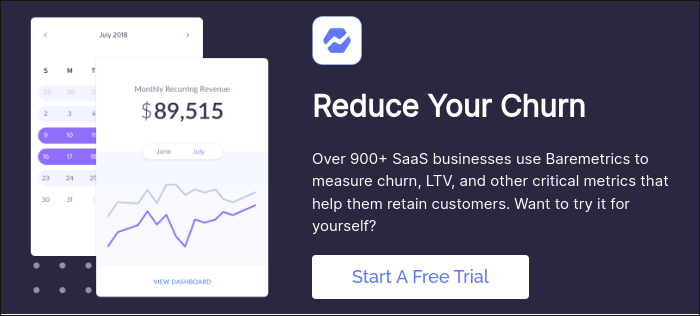Table of Contents
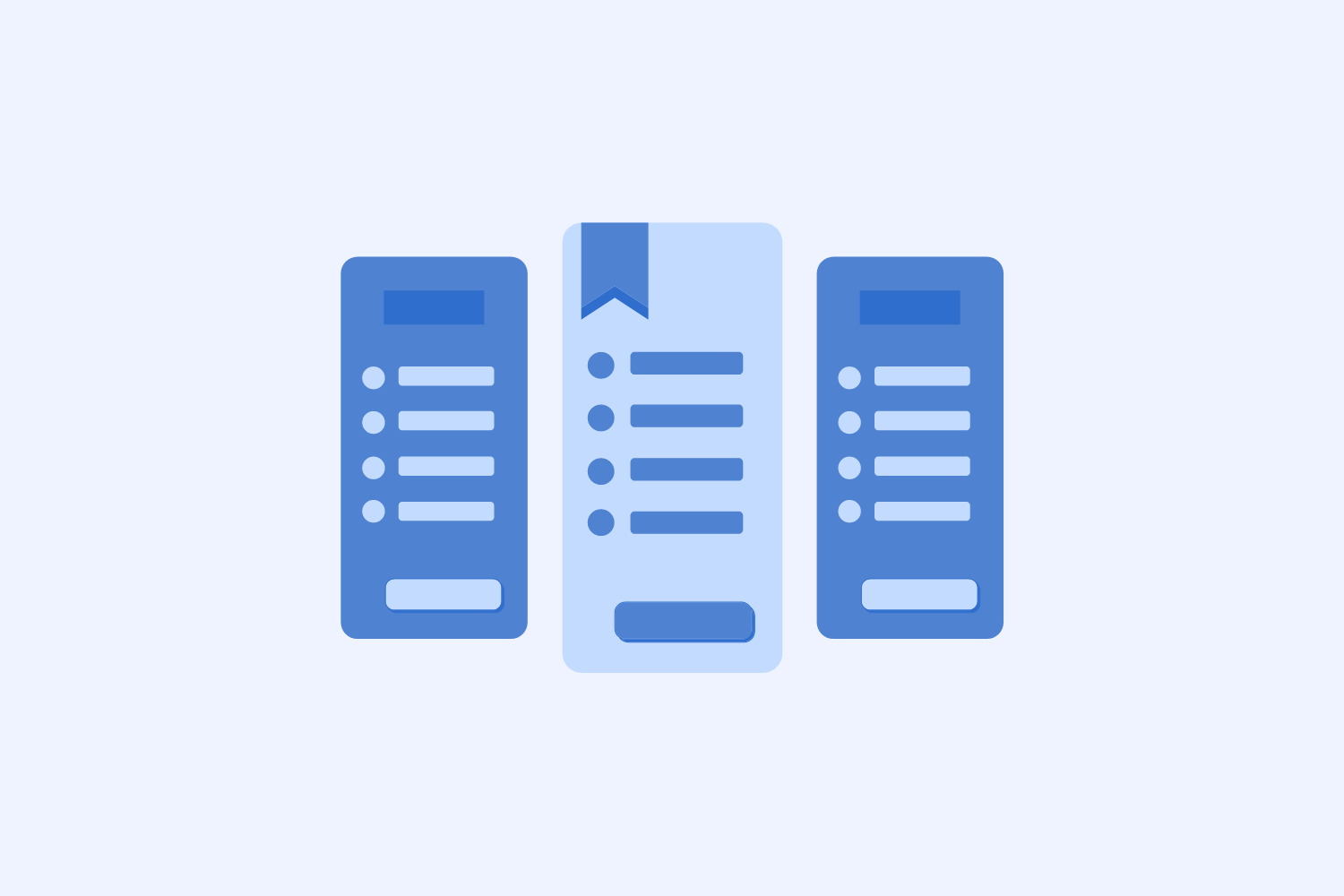
Sometimes it pays to keep things simple. Like, literally.
Perhaps this is why tiered pricing is so popular for SaaS companies.
That’s because the concept of picking a service plan is tried-and-tested.
Plus, the average consumer wants the freedom to choose their preferred “size” of service.
Small, medium, large. Tall, grande, venti. You get the idea.
Stuck on picking a pricing model for your product? Tiered pricing is probably your safest bet.
And In this guide, we’ll break down everything you need to know about packaging your service into tiers, why it makes sense and the best practices for doing so.
What is tiered pricing?
Definition time!
Tiered pricing is a SaaS pricing model in which cost is based on the tier of service chosen by your customer. The cost of each tier (think: a plan and package) is incremental, determined by factors such as features and usage limits included in any given plan.
Simply put, tiered pricing involves bundling your services into separate plans. Customers are then tied to their plan on either a monthly or annual basis, often receiving a discount (~10%) for picking a longer-term plan.
Below is an example from Formstack, where customers can choose between four pricing tiers, ranging from “Bronze” to “Platinum.”

Pricing tiers are typically presented on a spectrum. Free or “starter” plans will have fewer or limited features, whereas more expensive plans will offer premium functions, unlimited usage and so on.
Below is another example from Zendesk:

Tiered pricing centers around the concepts of choice and flexibility, which represents a sort of win-win for companies and consumers alike.
For businesses, you can appeal to more customers regardless of their budget(s) and put more responsibility on your customers to make the “right” choice.
Meanwhile, buyers don’t feel pressured or locked into a one-size-fits-all plan.
What are the benefits of tiered pricing?
Beyond the upsides we’ve already discussed, let’s look at some of the key benefits of tiered pricing.
You can tailor your product to a wider range of customers
This is the big one.
Pop quiz. Would you rather have an army of small-ticket customers paying $5/mo or a couple of heavy-hitters paying enterprise fees for your service?
According to our Twitter followers, it’s the latter.
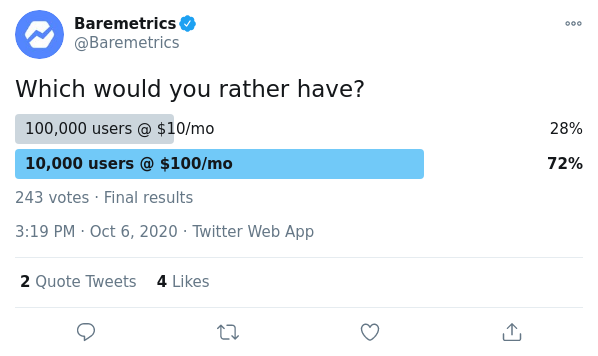
Luckily, with tiered pricing, you can do both and then some.
Rather than pigeonhole yourself into being a “discount” or “premium” service-provider, you can offer plans that appeal to a variety of budgets. For example, you might offer a range of plans tailored toward:
- Individuals (or solo businesses)
- Small teams (2-5 employees)
- Startups
- Enterprise customers
See how that works?
Tiered pricing is pretty much universally understood
Again, tiered pricing is easy to understand for businesses and buyers alike.
From your smartphone plan to your Internet package, people “get” packages. They’re not rocket science. Before anyone even lands on your pricing page, they’ll likely assume you offer multiple service plans anyway.
The less confusion there is around your pricing, the higher your chances of converting leads into customers.
Upselling is easy as users scale and see the value of your product
Much like the SaaS business model itself, tiered pricing creates a sort of natural progression for your users to upsell your service as their business grows.
The more value your product provides (think: saved time or money), the more likely users are to upgrade. You obviously can’t upsell customers if there’s no bigger plan for them to sell to ‘em.
Read:How to Improve Your MRR Growth Rate (without new customers)
What are the downsides of tiered pricing?
Tiered pricing is both popular and straightforward, but it’s not necessarily perfect. Let’s look at some of the potential pitfalls of tiered plans and packages.
Understanding tiers requires a higher level of awareness from your leads
If your leads aren’t product-aware, they might see your pricing copy as gibberish.
“Do I really need an ‘unlimited’ plan? I could probably get by with 50GB/mo. Right? What the heck is ‘white-labeling’ and why does it cost so much?”
Without a keen understanding of their needs and what each plan is offering, your leads are going to have to do their homework to figure it out.
Although they may be able to do so by reaching out to your sales department, watching a demo or reading a blog post, you’re putting extra work on your prospects. This lag-time could likewise lead them to research a competitor if you aren’t swift to clear up their confusion.
You can combat this by adding tooltips or descriptions of the different features you get for each plan, like DocuSign does here:

Users might not always pick the tier that’s “right” for them
Piggybacking on the issue above, the freedom of choice presents a distinct problem: users making the wrong choice.
That is, let’s say a new user is disappointed by their “starter” plan when they should have opted for the “startup” option. This could lead them to think that your tool is bare-bones.
On the flip side, a smaller company could feel that your bigger plans are bloated or otherwise expensive for the features that they actually use.
If you don’t price out your tiers properly, you could be losing out on revenue
Unlike usage-based pricing where customers get exactly what they pay for, poor pricing could mean that your customers are getting enterprise-level features at small business prices.
There’s plenty to consider when pricing out your plans (think: how much to charge, the sort of feature cutoff point between tiers, etc). Rushing your pricing structure could result in a ton of money on the table if you aren’t careful.
be honest
How well do you know your business?
Get deep insights into MRR, churn, LTV and more to grow your business
What are the best practices for tiered pricing?
Let’s say you’re confident about offering tiered pricing but want to double-check that you’re getting it right. Below are some best practices and tips for implementing your plans and packages.
Give your service plans simple (and self-explanatory) names
The best way to highlight who your plans are intended for is as simple as naming them.
For example, Loom’s “starter,” “business” and “enterprise” plans are clearly labeled. They’re likewise coupled with subheaders that highlight their key features.
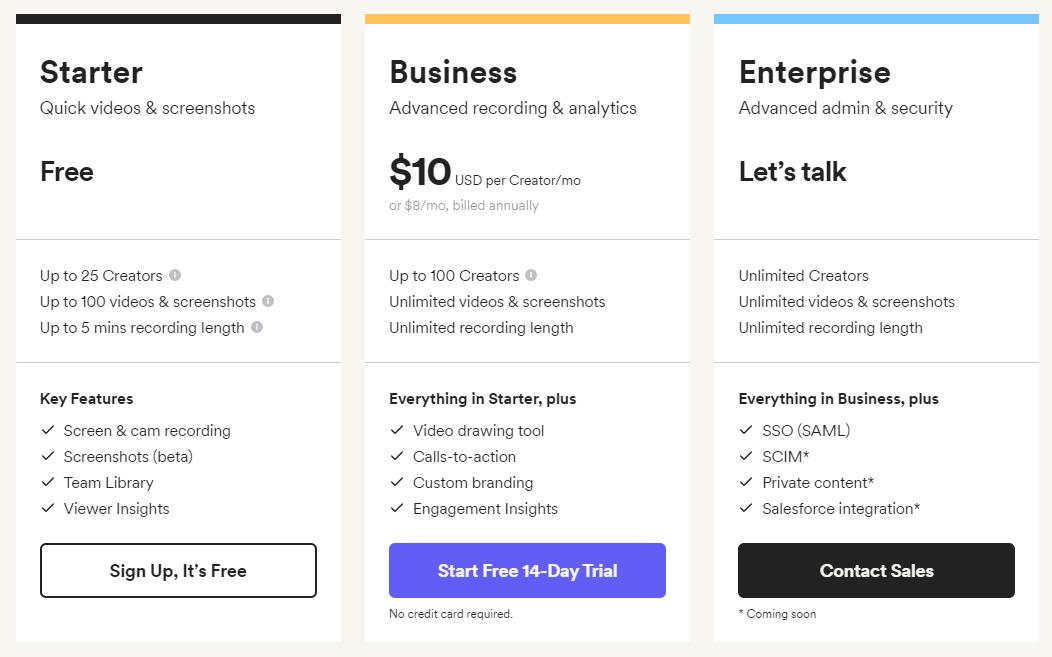
In fact, your subheaders can do a lot of the legwork of telling your prospects “Hey, this is for you.” Here’s another good example from Zoom (“great for small teams”).

Now, compare this to HostGator who uses terms like “hatchling” and ‘baby” to describe their packages to go along with their gator-based branding.
Although bigger companies might be able to get away with this, up-and-coming businesses should plainly spell out their plans.
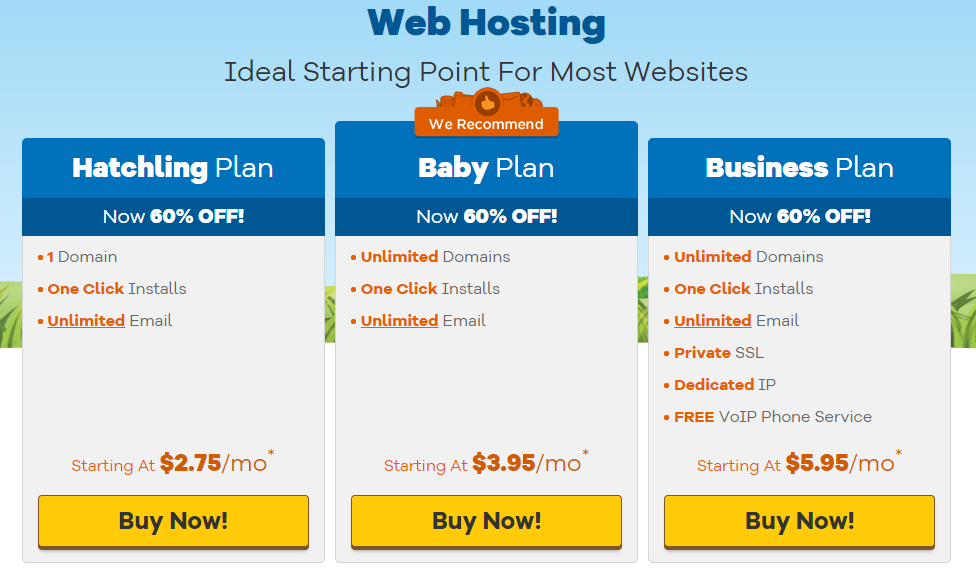
Avoid overwhelming your users with plans (hint: try to stick to 3-4 tiers)
For the sake of simplicity, try to find a sweet spot in terms of how many tiers of service you offer.
Three or four seems to be the sweet spot for most companies. The former sticks to the sort of “small,” “medium,” “large” pricing methodology discussed earlier, while the latter often includes some sort of free or premium plan.
The key here is that you don’t want to cause analysis paralysis by giving people too many choices. When in doubt, think “less is more.”
You can also get creative with how you present your prices as ClickUp does. For example, their pricing page presents a binary choice which then expands their offerings.
This is a brilliant way to gauge the interest of paid users without hitting them over the head with information.
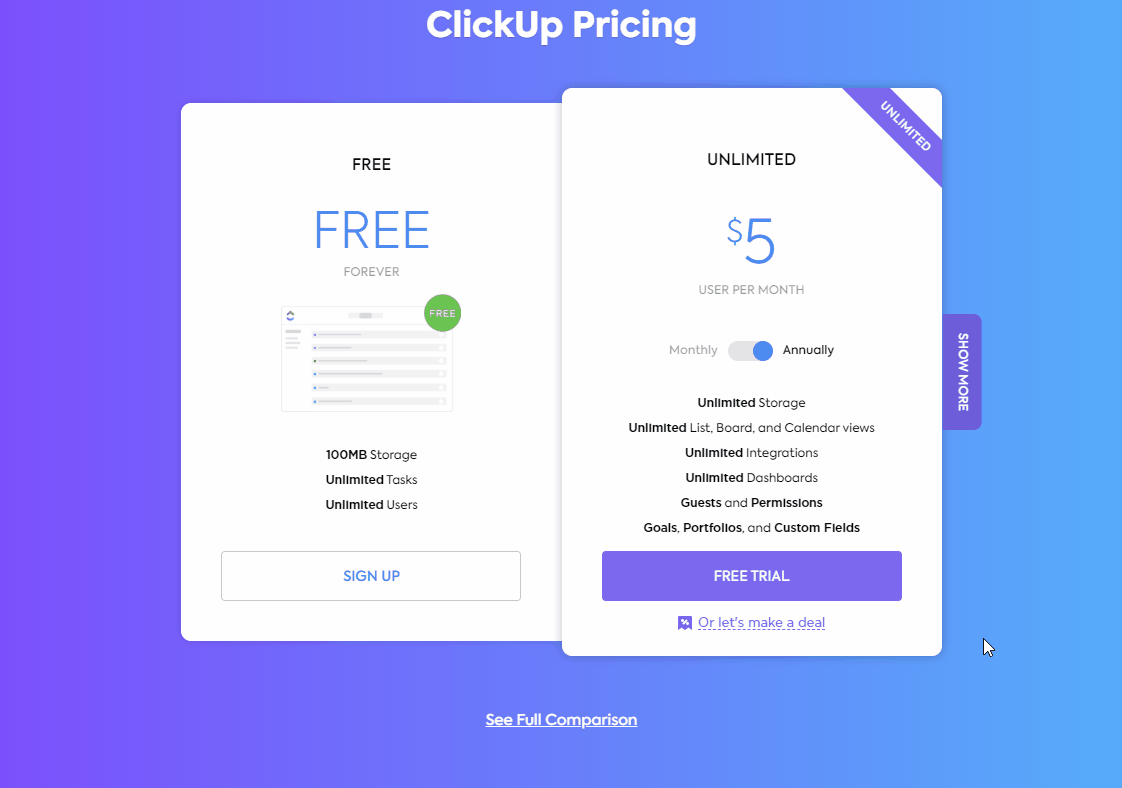
Present a “preferred” plan to give your users a much-needed push
Notice that many companies create a sort of bandwagon effect by highlighting a particular plan as being “recommended” or “most popular.”
Doing so naturally nudges your customer to make a choice and likewise avoids overwhelming them. Below is an example from OptinMonster:

Here’s another example from Sendlane whose recommended plan is actually their most expensive one (typically this isn’t the case). The fact that this plan isn’t presented last actually helps draw more eyes to it (and the hot pink certainly helps, too)
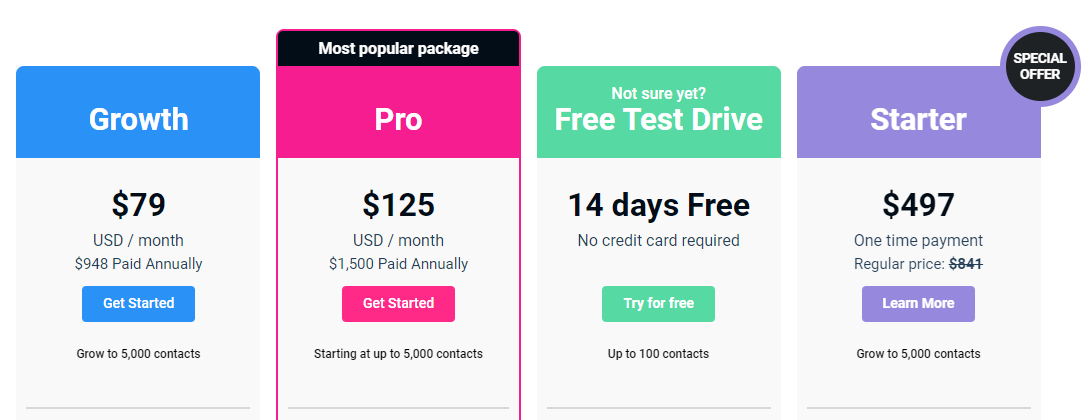
Similarly, Flock puts their preferred plan first and likewise draws visitors in with their color scheme.
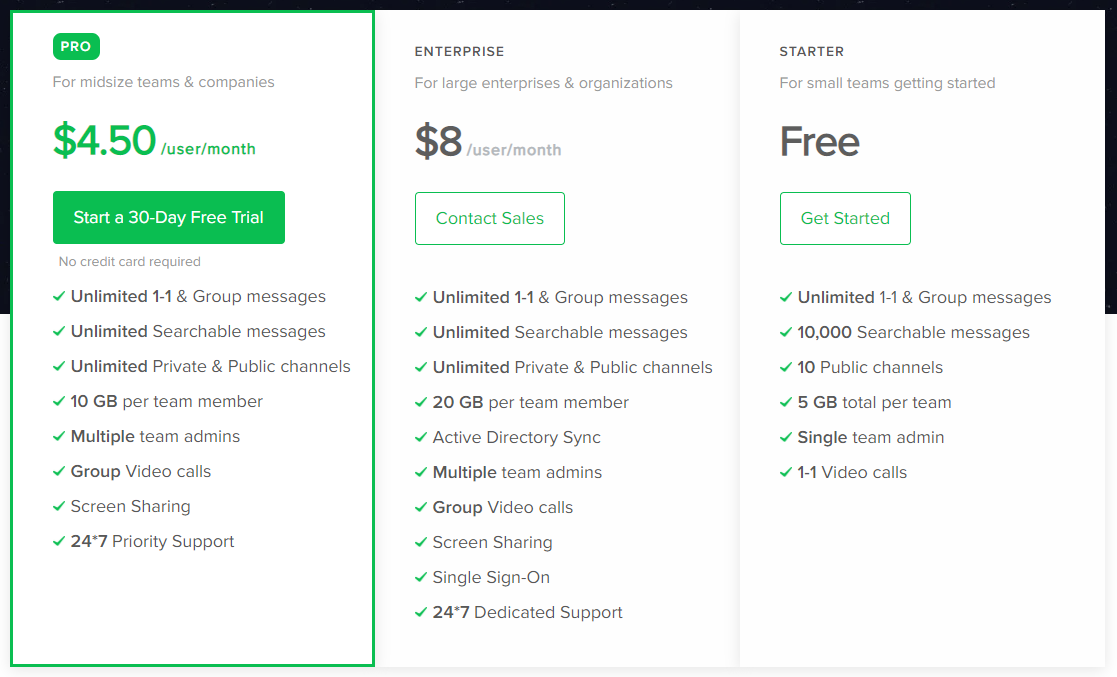
Use anchoring to highlight additional features in higher-tier plans
Getting people to your pricing page is a tall order. You obviously don’t want to waste any precious above-the-fold real estate on the page by repeating the same features over and over.
Through the technique of anchoring, you essentially present your first plan as the “starting point” for the rest of your others. This allows you to highlight more specifics of your higher-tier plans to cement how good of a deal your customers are getting.
Here’s an example of anchoring from Fomo…
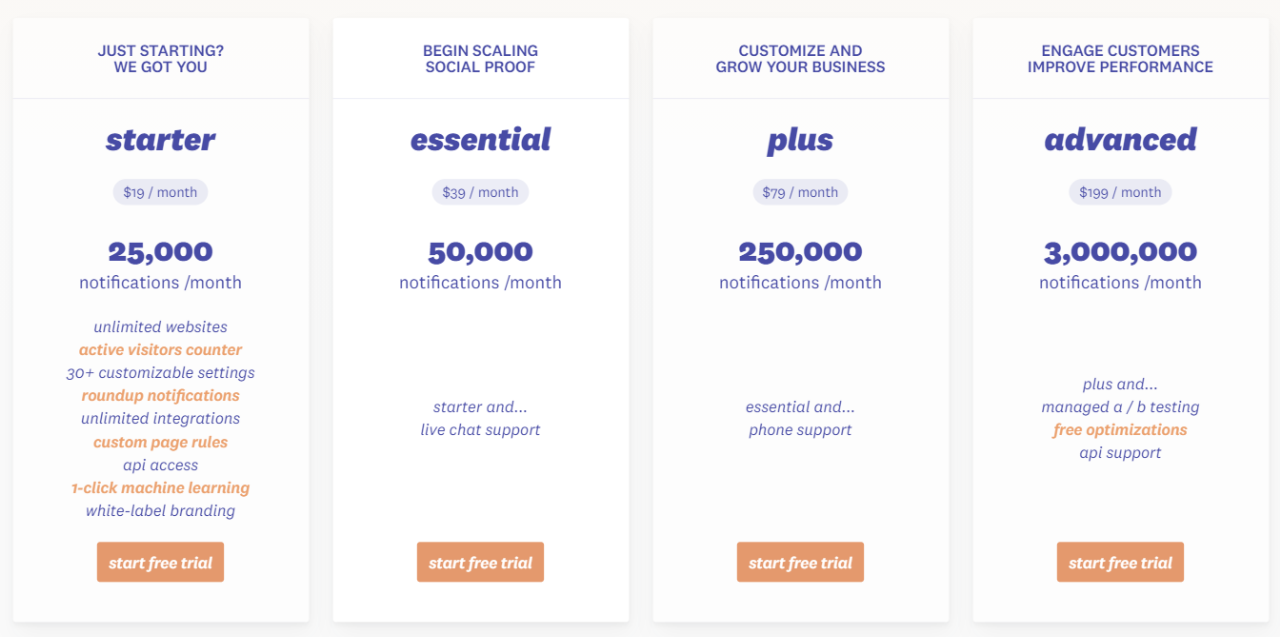
…and another from Heap…
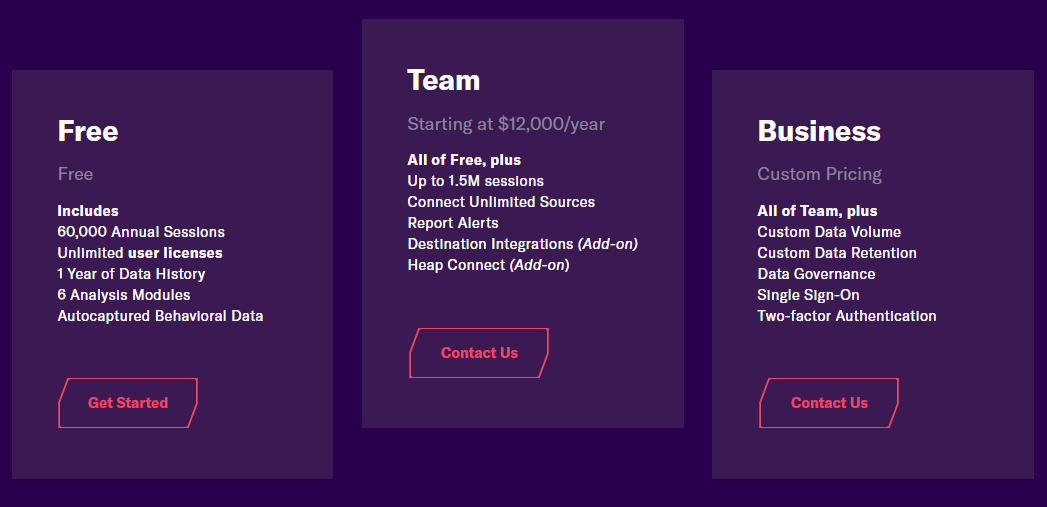
Emphasize easy upgrades (or downgrades) from one tier to another
If you’ve ever had to switch health insurance or cell phone plans unexpectedly, you know that doing so can be an absolute nightmare.
That’s why you should state that changing plans is quick and painless for your customers. Easy upgrades help with customer retention as you encourage your customers to stick with you long-term regardless of plan rather than bounce.
Check out below how JotForm emphasizes flexibility when it comes to making a switch.

Make sure no two tiers are too close in terms of pricing or features
Finally, make a point to create clear distinctions from one tier to the next.
Remember what we said earlier about accidentally giving bigger-tier customers a steal? It may take some fine-tuning, but make sure there’s enough of a difference between any given plan that your customers don’t just default to whatever is cheaper.
Check out how Sleeknote creates separation between their plans:

Related Read: How a tiny pricing change (not a growth hack) tripled revenues
Who is tiered pricing best for and does it make sense for your company?
Plans and packages go hand in hand with SaaS.
Again, tiered pricing is the go-to for most companies because it’s so straightforward and offers some much-needed flexibility for customers. It’s the pricing structure that most businesses default to because, well, it works.
To wrap things up, we’ll quickly recap who tiered pricing is best for.
B2B SaaS Companies that want to appeal to startups and enterprises
Some companies have massive SaaS budgets and are juggling tons of tools.
Others might be stuck on a shoestring budget for the time being.
All of the above could potentially be your customers through tiered pricing. If you have a product with a diverse audience in terms of budget, you should definitely offer tiered plans and packages.
Companies that don’t have to worry about API or server-side costs
This might be a no-brainer, but you shouldn’t offer tiered pricing if you’re eating a ton of server-side costs. Tiered pricing should ensure that you make more money off of bigger-ticket users, not less.
Companies that strive for consistent revenue
By encouraging users to adopt monthly or annual plans, you’re less likely to second-guess your revenue goals or be inconsistent with hitting them.
The benefits of doing so are well-documented as you have a better pulse on how much money you’re making month-to-month.
Coupled with tools like Baremetrics, you can also get an idea of which plans are the most popular, how much you’re growing and how often your users downgrade or drop out.

Should you use tiered pricing?
Listen: you can’t start seriously selling until you’ve priced out your products properly.
Through tiered pricing, you can appeal to a wider array of customers and offer flexibility to your buyers. Doing so is safe and proven for SaaS companies, so you should definitely explore putting together tiers if you’re on the fence about how to price your services.
To dig into more pricing strategies, check out our Top 10 Pricing Strategy Examples for SaaS.
Either way, just know that Baremetrics can help you track your revenue targets and customer numbers regardless of your pricing structure.

